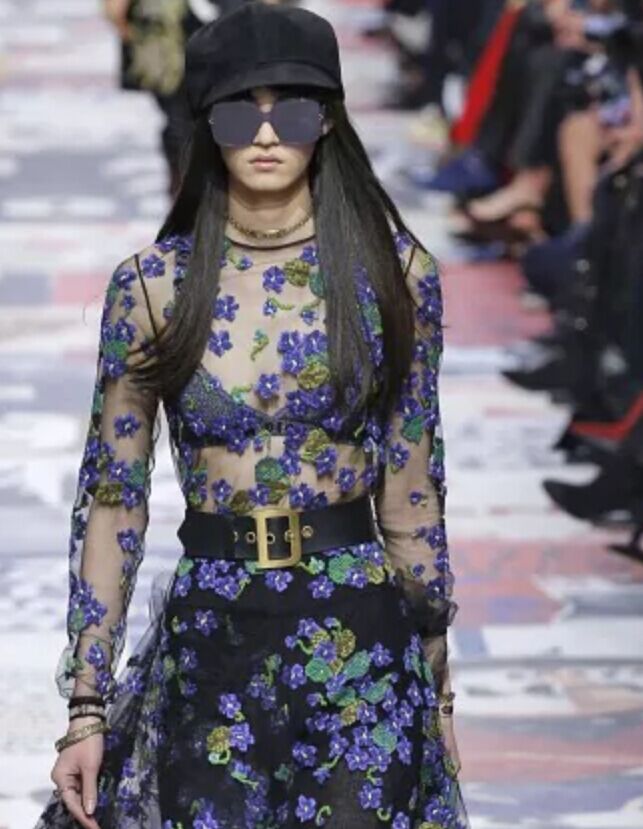Paris – A presentation by Christian Dior in a speech to be held at the Rodin Museum on the afternoon of Tuesday, 2018. Guests walk down the narrow stone walkway, which has been partially blocked by police barricades, passing through cameras, passing through baggage checkpoints and hand-held metal detectors, through the museum corridors, where it safely keeps track of any sudden The Selfie moves and enters a huge tent decorated with political leaflets and a 1960s Vogue covered patio.
As the Dior show under the direction of Maria Grazia Chiuri, it naturally becomes a feminist visual essay. Since her debut at home in the fall of 2016, designers have been firmly rooted in her Dior edition, incorporating feminist politics, women’s indomitable spirit and their unlimited potential. Chiuri is the culprit for the creative women of the first prestigious French house in more than 70 years, a difference that she would not take it lightly.
For two years, Chiuri provided her audience with an accelerated course on women’s studies, with particular emphasis on the long-term effects of patriarchy. She has taken the T-shirt to the runway, transforming the voice of gender equality into a sign that “we should all be feminists.” Is she quoting inspiration as a great female artist in Linda Nochlin’s late 1971 groundbreaking art history article Why Where? “She has celebrated the most recent work by feminist writer Chimamanda Ngozi Adichie.
Along the way, Chiuri has talked about the implications of a huge creative business and boutiques, global productions, advertising and international reputation networks. She described herself as a woman, figuring out what it means to be a modern professional with a complex combination of aspirations and obligations. (It is perfectly reasonable to talk about elections and embroidery in the same conversation, why do we work hard to pretend it is not?)
Chiuri chews her audience extensively. But in the end, her main responsibility is clothes: their appearance, their charm, their function. Of course, there are situations in which Chiuri also asks her audience to consider how the Womens Sexy Dresses can further her conversation about feminism.
She added a big burden to several Womens Sexy Dresses. She blessed her to look high.
In the fall, Chiuri was inspired to explain in her performance notes that the Paris uprising of 1968 opposed the French nation, its bourgeois tradition and its rules of disregard for women. From the government elite to the working class, this is a subversive social resistance – a violent conflict led by young people.
For the fashion industry in 1968, there were basic logistical problems in production and sales. When some parts of the city are riot areas, rich clients will not come to Paris? But there are also concerns. Will this new generation of provocative young women allow themselves to be dictated by designers in high fashion studios? Will they be involved in fashion formalities?
Dior itself is the object of their anger at home and abroad, women raised angry placards, and conservative brand conservative skirts and aggressive way dismissive.
Chiuri digs into these complex times, and there is a series that exudes Haight-Ashbury charm. Although it started with ordinary down jackets and matching jackets, it quickly evolved into a collage jacket, Womens Sexy Dresses and embroidered Womens Sexy Dresses reminiscent of Woodstock. Chiuri mentions the “youthful light” of the 1960s fashion, when miniskirts and boots were popular. From a modern point of view, she pays tribute to Anna Sui, an American designer who has persevered in the fashions of a festival during her long career.
All this is very good clothes, but what is the relationship with Dior? What role does it play in feminist cultural conversations? Are these the clothes that Christine Dior himself should offer women’s wear in 1968? This is Chiuri – a woman – what services are available at that time? This is Chiuri hope Dior can do it?
People generally do not like the likes of Dior and Big Brother Koché, four years ago. But here it seems, in part, because both are headed by women. They show their work only hours later, and both seem to be striving to resonate out of showrooms and runways.


